The Microsoft Surface Book First Look
by Brett Howse on October 21, 2015 9:01 AM EST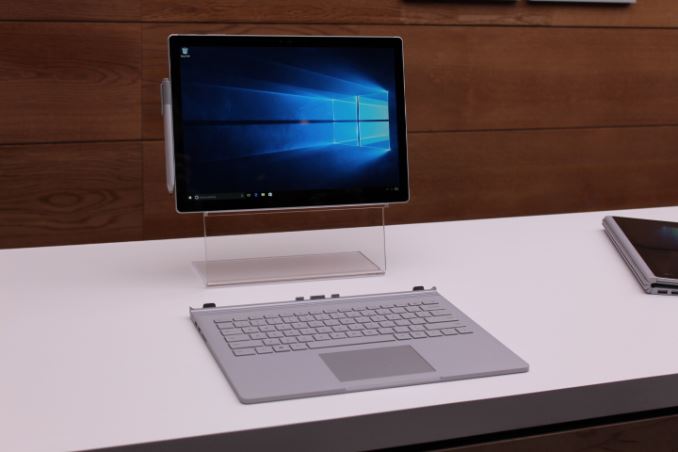
Today is the official launch day for not only Microsoft’s Surface Pro 4, but also the Surface Book which was announced back at the Microsoft Windows 10 Devices event. There had been rumors of a larger form factor Surface Device, but launching it as a “The Ultimate Laptop” was certainly unexpected. Microsoft has tried to break the mold compared to the standard Windows Ultrabook, with a detachable display, which they call a Clipboard, and an optional GPU in the base. By moving the CPU and other components into the display, it has certainly freed up the base for extra battery capacity as well as the GPU, something that would not be thermally possible in a normal Ultrabook.
I was lucky enough to receive a Surface Book at the event, but the pre-production unit that I received had a defective keyboard. Due to very limited supply initially obtaining a replacement unit was difficult, but Microsoft came through with another sample. Due to the time needed to swap I haven’t had time to do a full review yet, but being that this is the launch day it’s important to offer a preliminary showing on the Surface Book. We have some results for both the base Core i5 model as well as the Core i7 version which comes with the NVIDIA GPU in the base.
| Surface Book | |||
| Core i5 | Core i5 w/GPU | Core i7 w/GPU | |
| GPU | Intel HD 520 | Intel + "NVIDIA GeForce" (Approx. GT 940M) w/1GB GDDR5 |
|
| CPU | 6th Generation Intel Core i5-6300U (15w) | 6th Generation Intel Core i7-6600U (15w) | |
| Memory | 8-16GB RAM | ||
| Display | 13.5" IPS 3000x2000 resolution 1800:1 Contrast Ratio 100% sRGB, individually calibrated 10 point touch and Pen support |
||
| Storage | PCIe 3.0 SSD 128 GB to 1 TB | ||
| I/O | USB 3.0 x 2 (In Base) SD Card reader (In Base) Surface Connector (In Tablet and Base) Headset Jack Mini DisplayPort |
||
| Dimensions | Laptop (mm) : 232 x 312 x 13.0-22.8 (inches) : 9.14 x 12.3 x 0.51-0.90 Tablet Only (mm) : 220.2 x 312.3 x 7.7 (inches) : 8.67 x 12.3 x 0.30 |
||
| Weight | Laptop 1.515 kg / 3.34 lbs Tablet Only 726 g / 1.6 lbs |
Laptop 1.579 kg / 3.48 lbs Tablet Only 726 g / 1.6 lbs |
|
| Camera | Windows Hello (Front) 8 MP Rear Facing 5 MP Front Facing |
||
| Price | $1499+ | $1899+ | $2099+ |
First, I think the one piece of information that most of our regular readers are curious about is the GPU. At the launch event, Microsoft was pretty guarded about what GPU model was in the Surface Book. Their specifications just listed it as an "NVIDIA 8G" part, which was a custom Maxwell based GPU.
Taking a look at the GPU in our samples leads us to the conclusion that it is most certainly a GM108 based GPU, with specifications fairly close to the GeForce GT 940M. There are 384 CUDA Cores available, but the custom part is the memory. Normally GT 940M would come with 2 GB of DDR3 memory, and Microsoft has instead gone with 1 GB of GDDR5, trading memory capacity for improved GPU performance through additional memory bandwidth. This is a pretty typical tradeoff in lower-end GPUs, however to ship 1GB of GDDR5 in a mobile part in 2015 is quite unusual to say the least. Even GM108 should benefit from GDDR5 (thanks to its narrow 64-bit memory bus), but with only 1GB of memory it's going to be cramped.
Moving on, the GPU connects over PCIe lanes provided by the Surface Connect port between the Clipboard and base.
Microsoft does have Optimus enabled, with the default setting in the custom control panel for Auto-Select on the GPU, but you can also change to integrated or the NVIDIA graphics. There is no GeForce Experience installed, so in order to make the change you have to dive into the Control Panel. It’s not very elegant but I think the idea is that you just leave it in auto and let the whitelist handle when the dGPU is enabled. My experience so far is that the whitelist seems a bit bugged right now, and the dGPU runs all the time when the Clipboard is docked, which is clearly not the way it is intended to be.
With the GPU information out of the way, let’s dig into what makes the Surface Book so unique. The basis of the Surface Book is that it is designed to be used as a laptop most of the time, but the display can be removed as a Clipboard for use with the pen. The Surface Book is certainly not the first device to do this, but it does some things in new ways that are pretty interesting.
The display sticks with a 3:2 aspect ratio, the same aspect ratio as the Surface Pro lineup. This makes the Surface Book considerably taller than pretty much every laptop out there, with maybe the exception of the Chromebook Pixel if you want to count that. For what feels like too long, the standard Windows laptop comes with a 16:9 display, and even prior to that the standard was 16:10 which is slightly taller than 16:9. Moving to 3:2 on a notebook brings a lot of vertical space and makes it a lot easier to be productive on, at least in my experience in my short time with a review unit.
The Clipboard itself is pretty nice too, and with the decision to not include any USB ports on the display section, it gave Microsoft the ability to make the tablet portion even thinner than the Surface Pro 4. At just 7.7 mm thick, it is noticeably thinner than the 8.4 mm Surface Pro 4 even though it doesn’t sound like a big difference. At just 726 grams, the Surface Book display is even lighter than the Surface Pro 4, despite the larger 13.5-inch display compared to just a 12-inch display on the Surface Pro 4. The way they got it so light was to not include much battery cacity, with the display only packing 18 Watt-hours. The idea is that the Surface Book is used as a notebook most of the time, but if you find occasions where the tablet would be handy, you detach, so really long battery life is not the priority.
The base though is almost a blank canvas. By putting all of the major components in the display, not only have they made room for a GPU in an Ultrabook form factor, but they also have room for a lot more battery than most notebooks of this size. The additional 52 Wh of capacity in the base is as much battery as most Ultrabooks have. Combined with the 18 Wh in the Clipboard, the Surface Book packs in an impressive 70 Wh of capacity. I’ve run some battery tests already but I need to run a few more before I’ll have a good set of results so this will come with the review.
One thing the Surface Book does pack in is good performance. The Skylake 15 Watt processors are great for day to day tasks, and the GPU only puts it further ahead of most Ultrabooks. I’ll save the full performance figures for the review, but here’s a taste of what the GPU can bring to the table. Valve has recently revamped the Dota 2 game with a new Source 2 engine, and we’ve run a new version on a couple of devices to see how it fares.
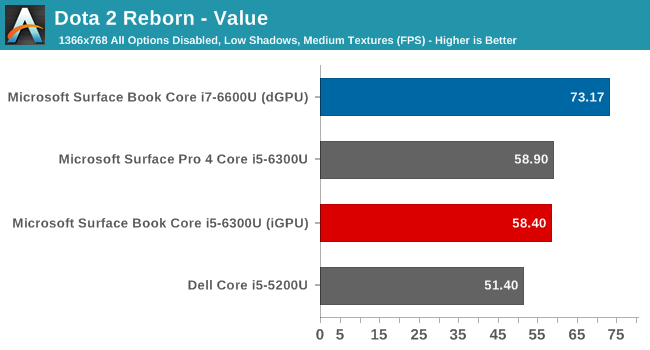
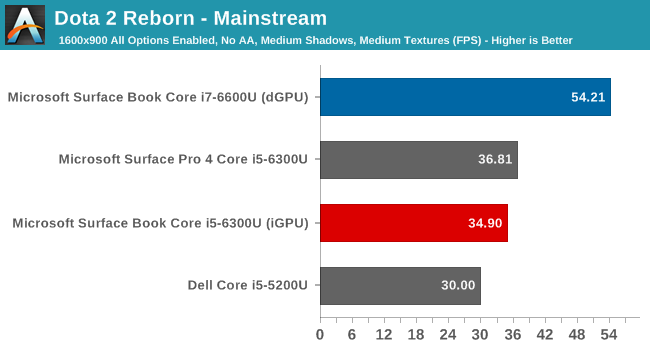
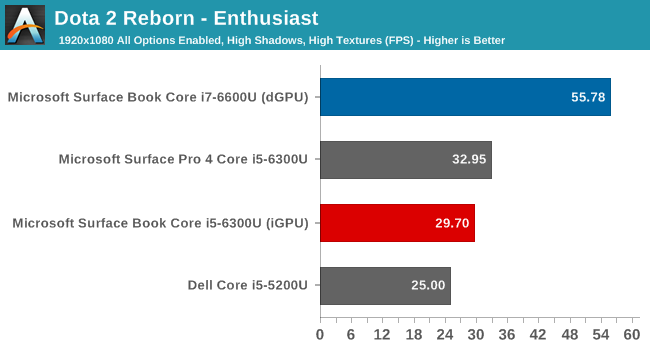
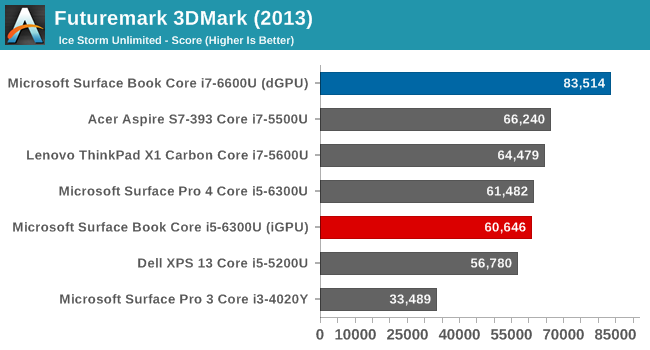
The performance increase of the discrete GPU is a sizable jump over the integrated graphics of Skylake, and by moving the GPU into the base away from the processor, Microsoft is able to put the GPU in its own thermal zone. We don’t have exact TDP numbers from NVIDIA, but the GPU should be somewhere under 30 Watts. There is no way to fit that kind of TDP into a normal Ultrabook.
The Core i5 and i7 options offer performance right on par with other Ultrabooks too. Having a full 15 Watt Core processor in a 7.7 mm chassis is fairly impressive, especially since you almost never hear the fans kick in. Here is a taste of the CPU performance.

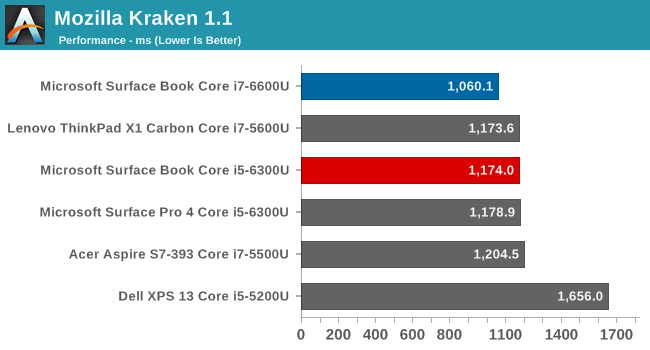
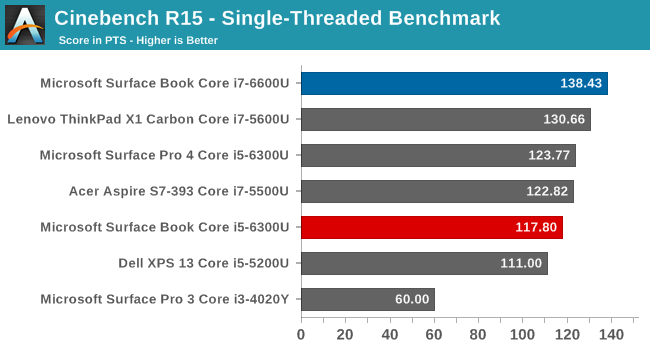
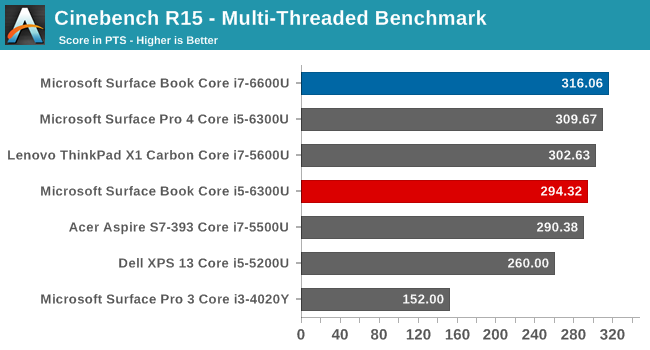
Obviously one of the signature design elements of the Surface Book is the hinge. I think this might be somewhat a love it or hate it idea. The hinge unrolls and actually lengthens the base of the notebook. Balance is the key here. With the majority of the notebook parts in the display, Microsoft is trying to avoid the one pitfall that most detachable 2-in-1s have, which is their tendency to tip backwards. By extending the base, Microsoft needs less weight in the base to overcome that balance issue. I’ve been told that the design means that they can get by with a 0.8:1 ratio of base mass to display mass. The other benefit of having the strange hinge which does not close completely is that the keys never touch the display. Most notebooks have the keyboard sunken in the deck, which reduces the maximum key travel. The extra room provided by the hinge lets Microsoft offer a 1.6 mm key travel on a very thin base. It also lets the Surface Book actually look like a book when it’s closed, which is a nice take on the design.
The Surface Book is a very interesting take on the Ultrabook by Microsoft. I’ll need some more time with it to get a full review completed, but initial impressions are that it’s a solid device with a great display, a good keyboard, and a generous trackpad. The overall device is not as thin or light as some other Ultrabooks, but generally those don’t pack in 70 Wh of battery and a real GPU. Stay tuned for a full review soon.


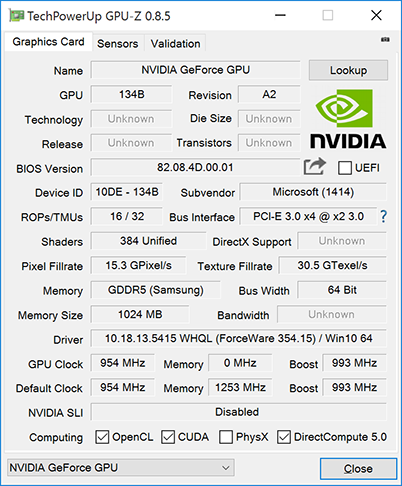
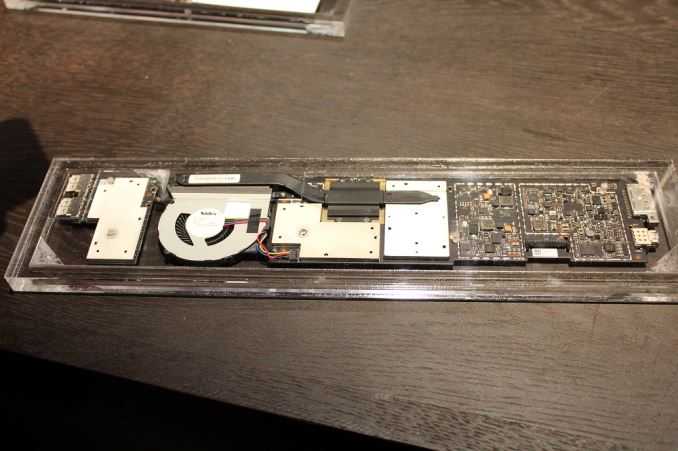

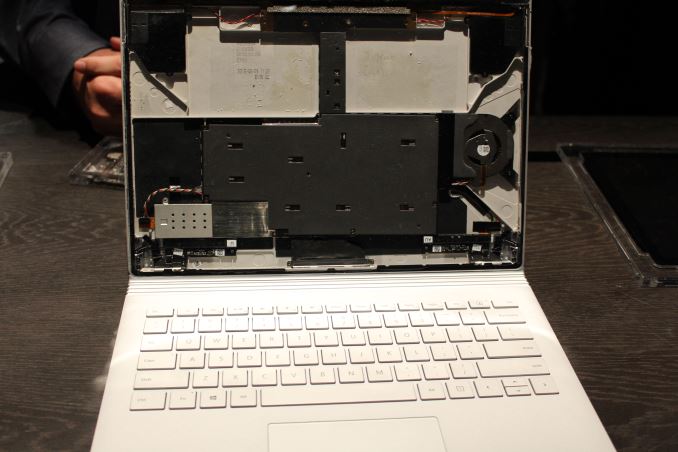
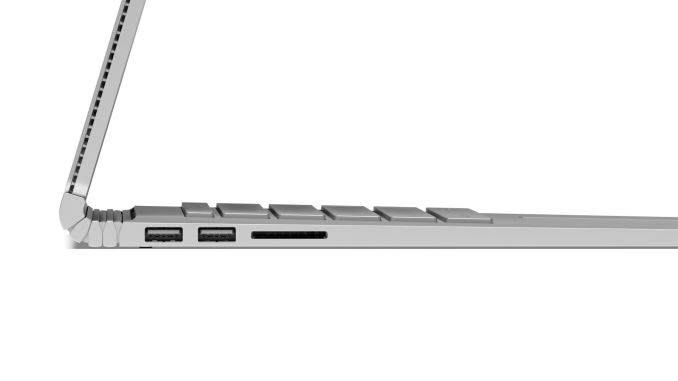








101 Comments
View All Comments
TEAMSWITCHER - Friday, October 23, 2015 - link
Why didn't they make a 15" Surface Pro with a quad Core i7 CPU with Iris Pro graphics? For me, the DGPU in the Surface Book is too meager for the extra money. The rest of the Surface Book specs are too much like the ultra portable Surface Pro 4. The Surface Book in it's current form is Microsoft's "Why the hell did they even bother making this?" deviceAlexvrb - Friday, October 23, 2015 - link
15" is a different class of device. Obviously a larger device can be equipped with more horsepower. There's plenty of larger devices on the market that prove that. They often come with more-powerful dGPUs. This 13.5" device competes with other 13.x-14" Ultrabooks and slim convertibles, which is a more lucrative segment right now. 15" has too much competition and lower margins.Anyway just because this isn't what you're looking for doesn't mean other people aren't looking for a device of this size. Do you often look at compact sedans and go "Why the hell did they even bother making this? I'm in the market for a large car and thus all vehicles produced should be full size sedans." :-P
Landiepete - Monday, October 26, 2015 - link
Because then you would be complaining about the weight of the tablet. Or someting else.trane - Wednesday, October 21, 2015 - link
Actually, 1GB is a pretty good match for a 384CC part. It's never going to play core games well anyway, the GPU will always bottleneck before the mem buffer. So most people are going to use this for Photoshop, CAD, e-sport games etc, which use even less VRAM; and 1GB GD5 is a better option than 2GB GD3 anyday for perf. Let's face it, 2GB GD5 isn't worth the battery life impact, which could be an hour or two.Can't wait to see a HBM GPU inside the next one though! I wonder if that was the intention, but with the delays to FinFET it never materialised in time.
ddriver - Wednesday, October 21, 2015 - link
1 GB is simply too low for this device native resolutiondragonsqrrl - Wednesday, October 21, 2015 - link
I don't think anyone is expecting to run games at native resolution. And even if you did, would the memory capacity really be the bottleneck?ddriver - Wednesday, October 21, 2015 - link
For games you can run at a lower resolution, but for professional graphics applications this is not an option.neonspark - Wednesday, October 21, 2015 - link
I'm not sure what you mean exactly. You can run integrated graphics and drive dual 4K displays at 60fps as the windows UI doesn't use any gpu use. Photoshop doesn't need more VRAM to "work" and it will not be faster because of it, as pointed out the gpu computations ARE NOT done on your resolution but on the raw data. That could mean a very large RAW file, a video file, etc. Typically these apps' UI doesn't do anything fancy. Toolboxes, bitmaps, vectors, do not stress the GPU in any way. Even with 3D cad software, your VRAM isn't going to be the limit because of the resolution, in particular because you typically render in a preview window at lower settings than your final output as that is likely going to be a job ran on a server farm. So I'm not sure why you imagine resolution = vram for anything other than gaming.Skylake integrated graphics can drive the display panel, plus two external 4K screens at 60hz and it doesn't even rely on GDDR5 to do it, let alone have 1GB of it.
I get it why you may "imagine" that 2GB would yield a benefit, but that is to a gamer, clearly not this product's target. For the professional, the biggest issue will be execution unit count, far before VRAM and resolution ever will.
ddriver - Wednesday, October 21, 2015 - link
You sound like you've never used professional software. All of it is now GPU accelerated, and the larger your viewport the more video memory you need. And on a high resolution display, the viewport will be quite large, and it is not like you will not go fullscreen, considering it is a mere 13.5 inch.I am willing to bet the single gigabyte of vram will prove to be a bottleneck in such scenarios. I would not be surprised if the integrated GPU with 2 gigs of memory ends up being better in some cases, despite being overall slower and ram being slower than vram.
neonspark - Wednesday, October 21, 2015 - link
I have used plenty of professional software and I'm a software engineer too. The viewport isn't going to be an issue here. For example, I process 36MP RAW images. The viewport will scale them because no LCD could fit them. When I run filters and processing using the GPU, in adobe CC and LR, the amount of VRAM isn't limiting here. I have ran the same jobs on machines with integrated graphics at 4K resolution, both using just a mediocre intel HD, as well as an older GTX card with 2GB and a newer GTX card with 1GB. The performance isn't tied to my resolution. I can change it to 4K, or 2K 1080p. This is because adobe's efficient viewports operate on the raw data, not the UI, and when they operate on the UI, such as LRCC, what gets pinged first is the CPU, followed by the GPU. Remember that the datasets for frame buffers in games are distinct from the datasets in scientific and graphics computation. Thus the most important aspect of the GPU for non gamers is the computational speed, not the VRAM figure, and last, the display resolution.The other part that you fail to understand is that VRAM is only needed for very fast memory access. The sofware can fall back on system RAM for everything else, and just leave the VRAM for the core algorithms that need it. The viewport rendering will be a factor in say, premiere CS, IF you want to do 4K editing at full res. But then again the screen isn't large enough for this. There is no question that the real time preview and of the premiere viewport will increase the load. But your claim that VRAM determines the performance of this window is ludicrious. The mercury engine will first tap out your GPU's execution units and 1GB is plenty for the frame buffer. Everything I've ever done has indicated this and you can try it for yourself. If you want to speed up, get more execution units before you get VRAM. Don't waste your money unless you're a gamer running huge frame buffers like say 16X AA, which does require the data to be in vram as to reduce the latency so that the framerate is sustained.